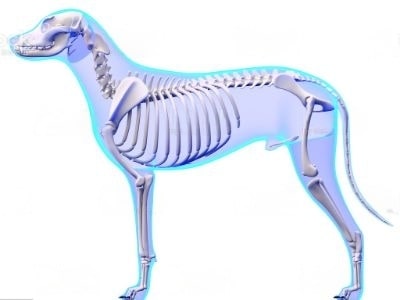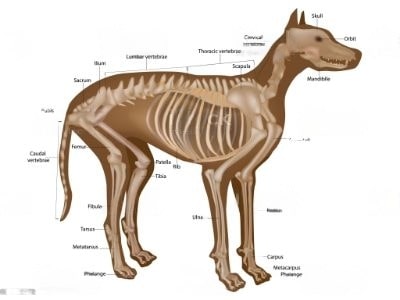When we normally think about bones, it’s mainly because we are either discussing the exact number within the body, recovering from a fracture injury, or just out of curiosity. Any instance can trigger this conversation. Likewise, dog owners also tend to get curious about the number of bones their dogs might have.
This article will simplify the details surrounding this curiosity and also give some insights into the skeleton structure of a dog, and highlight some common bone disorders in dogs. So, How many bones does a dog have? Let’s see.
You Might Also Like:
How Many Bones Does a Dog Have?
In general, dogs are said to have roughly 319-321 bones. The number is not specific, because there are lots of breeds and many variations in their skeleton structure. But, why the difference in the number? The answer is – tail.
A dog’s tail length plays a significant role in the number of bones it has. The shorter length will suggest fewer vertebrates and if the tail is longer, it’s more. In fact, some breeds have additional bones in their hind dewclaws. Still, if you want a specific number it’s 321. Here is an approximate distribution of the bones in a dog as per their skeleton structure:
- Heterotopic skeleton (baculum): 1
- Bones in the vertebral column: 50
- Skull and hyoid bones: 50
- Number of ribs and sternum: 34
- Bones in the thoracic limb: 90
- Pelvic limb bone count: 96
Now, before we get into the specifics of dog bone anatomy, it’s crucial to understand the skeleton structure of dogs.
Dogs Skeletal System

A dog’s skeletal system helps dog maintain its posture and navigate different movements. The skeletal muscles play a crucial role in doing so. Not only they are responsible for dogs’ activity and posture, but, also for their strength and stability.
The basic function of different bones in a Dogs’skeletal system
- Protect and support the body
- Operate as a lever for muscular action
In addition, the dog’s skeleton structure has 3 skeletal subunits:
- Appendicular skeleton (186): constitutes bones of the limbs
- Axial skeleton (134): includes bones of the skull region, spine, sternum and ribs
- Visceral skeleton: a subunit where bone forms part of an organ
Further, the skeleton of bones is also classified into different shapes i.e. short bones, long bones, and sesamoid bones. Short bones are capped to the wrist and ankle regions. The long bones are the ones found in the limbs, and the Sesamoid bones are close to freely moving joints, such as the knee and wrist.
In addition, there are also flat bones and irregular bones in a dog’s skeleton. The flat bones are found near the pelvis and they provide the extension for the muscles and the long bones. These bones also surround the eyes, ears, brain, and sinuses giving protection. The irregular bones contain the vertebral column, every skull bone that is not flat type, and 3 parts of the hip bone.
Dog Bones vs Human bones
The common distinction is obviously the count – we have 206 and dogs have roughly 321. However, there are some interesting differences between the skeleton structure. For instance, a dog’s front legs have the same bones as human arms and the rare legs, identical to how human legs are joined to the pelvis.
The common mistake people make is considering a canine’s upper leg as the lower leg and the lower leg is equivalent to the human palm/feet. Yes, the lower leg is similar to that of the human fingers/toes but, if you observe carefully you will see, they are bent, this orientation reduces the impact on the bones.
Further, the orientation of a dog’s skull is different from a human. The human skull is larger to hold a bigger brain and resides vertically. On the contrary, a dog’s skull sits horizontally and extends outwards.
Dog Bone Anatomy
Now we have the details of distinction, and skeleton structure, it’s time to get into the details of the bone anatomy of a dog. In this section, we will cover some of the significant aspects of different bones in detail.

#1 Bones of Skull Region
A dog’s skull is oval and extended. It has cranial and facial group bones around the region. Also, there are about 50 bones in the dog’s skull, including the mandible and hyoid apparatus. In addition, the structure differs according to breed. So, it’s possible some dogs may have different orientations.
#2 Vertebral column anatomy
Cervical, thoracic, lumbar, sacral, and caudal vertebrae are found in the vertebral column of a dog. There are 50 bones in a dog’s vertebral column and they vary as per the breed. Now, let’s get some details regarding the sternum and ribs of a dog’s skeletal system.
- Sternum: is made of 8 sternal segments which normally don’t fuse. However, they do fuse in adult dogs. The longest segment is in the manubrium. Also, the last segment is short and has a narrow end.
- Ribs: are in the axial skeleton of a dog and are cylindrical. There are 13 pairs of ribs, 9 pairs are sternal, and the remaining 4 are asternal ribs.
#3 Thoracic Limb bones
These bones have some fascinating osteological traits. Here, the spine of the dog scapula resides in the midline separating the lateral surface into two halves. The cranial and the caudal borders of the scapula are convex and the tuber scapulae are also sharp. In addition, the thoracic limb of a dog has 3 proximal carpal bones and 4 distal carpal bones.
#4 Pelvic limb bones
A dog’s hip bone structure comes with lots of variances. The ilium on the left and right sides of the dog’s hip is nearly parallel. Also, the crest of the ilium bone of the dog’s hip is convex. There is a twisted ischium in the hip of the dog and a massive variance in the ischial tuberosity of the dog’s hip.
Pelvic limb bones contain the same number of proximal and distal sesamoid bones as thoracic limb.
Bone Disorders In Dogs
In this section, we will observe some of the common joint and bone issues that occur in dogs. In fact, they may have some pre-existing condition in their bones or the surrounding region. So, as a dog owner, you must have an idea regarding these conditions, disorders or abnormalities to avoid any fatal health issues.
- Trauma
Trauma to bones is a common bone disorder found in dogs. Bone fractures or total dislocation from a fall or other accidental incidents result in such conditions. This traumatic experience is mostly found in dogs who are roaming freely.
- Luxating patella
A dislocation in the kneecap indicates that a dog is probably suffering from the luxating patella. In such a situation, the dog finds it difficult to move or stretch its knee at all. In addition, when a dog suffers from this bone disorder, the limping gets frequent, the pain elevates and ultimately it can result in arthritis.
Further, this medical condition can also cause chronic inflammation in the joint. As a result, the ligament of the dog breaks down. Also, as per the statistics, roughly 10-15% of dogs with luxating patellas damage their cranial cruciate ligament (CCL). In addition, if the positioning of the kneecap is more outside than the normal orientation, the space gets shallow and this in turn leads to dislocation.
- Panosteitis
This inflammatory bone disorder is also known as – long bone pain or, pano. Panosteitis occurs in growing puppies, the inflammation happens on the exterior part of the long bone. In addition, the inflammation mostly occurs in the legs.
Further, a puppy suffering from pano may also have issues with multiple bones. In fact, it’s quite possible that bones may have totally shifted their positions. The dog will show signs of discomfort in bone, lameness, lethargy and fever.
- Osteochondrosis
In this condition, the loss of cartilage makes the joints weak. A lack of calcium can make this condition serious. Dog bones lose their strength and in some cases, the cartilage is entirely detached from the joints. So, it’s crucial to provide a diet retaining high calcium content.
- Osteomyelitis
A bacterial infection causing inflammation of the bone is osteomyelitis. This infection can elevate in presence of bone implants such as pins or bone plates.
- Tumour
Dogs can get bone tumours and it can get nasty. Tumour is within the tissues of the bones and at times it also overspreads from the surrounding soft tissues. Osteosarcoma is one of the common bone tumours that occur in a dog. In fact, it’s a type of bone cancer, and according to PDSA, the majority of the dogs diagnosed with this tumour survive less than a year.
Additionally, there are some nutritional disorders that have a negative effect on the bones. Following are some of the instances suggesting the anomaly:
- Vitamin D deficiency in their food or the lack of exposure to daylight can hamper bone growth in dogs.
- The changes in phosphorus and vitamin D levels in the body can result in chronic kidney failure. In this condition, the bones become thin, soft, and weak.
- Rickets is another disorder that weakens bones. The condition occurs due to a lack of calcium and other imbalances in the diet. In the majority of cases, puppies or young dogs face this issue. In fact, puppies have it worse, they get fractures in their bones, disfigurements and feel lameness.
Diagnostic Tests
To evaluate the skeleton of dogs, vets use different diagnostic tests. These tests help in ensuring that the orientation is proper or addresses an underlying condition such as a bone tumour. Following are some of the diagnostic tests which helps vet get valuable insights into a dog’s skeletal system:
- Physical examination & palpation of bones
The initial evaluation of the skeleton requires thorough examination, with palpation of bones and joints. Vets look for any abnormalities in an examination room and assess the condition of different bones.
- Lab tests
Lab tests help a vet get a biochemistry profile of a dog. These tests reveal details such as blood count and highlight any possible infections or abnormalities in calcium levels and phosphorus. In fact, bone tumours, or kidney issues are also easily detected with routine lab tests.
- Bone biopsy
Bone biopsy is done to figure out the exact type of bone disease that a canine is suffering from. The biopsy gets crucial for detecting different bone tumours or osteomyelitis.
- CT and MRI
These imaging techniques are very helpful in examining bones and their adjacent soft tissues. Vets analyse dogs’ ligaments, cartilage, and tendons using these advanced methods.
FAQs
Do dogs have different bone structures?
Dog bone structure varies as per their breed. So, yes dogs have different bone structures and the size and shape of their bones differ accordingly. The main reason behind this variance is the breeding of dogs, especially cross-breeding. The bones of a dog will formulate based on their breed type as it has a major impact on how the thickness and length.
How long does it take for a dog’s bone to fully develop?
Most dog breeds take about 12-18 months to develop their entire skeletal structure. Although, the time taken for a dog’s bone to develop completely depends on its breed. For instance, small breed dogs reach their full development and stop growing within just 6 to 8 months, and larger breeds such as Mastiffs or Rottweilers may take more time i.e. 18-20 months to develop.
How many bones are there in a dog’s tail?
The tail of the dog is at the posterior end of the vertebral column i.e. the end of the backbone. In general, it contains about 6 to 23 vertebrae, which are covered in flexible muscles making the circular movement of the tail easier.
How many bones are there in the spine of a dog?
The spine or vertebral column of a dog consists of about 50 bones. The spine constitutes different vertebrae. So, there are 7 cervical vertebrae, 7 lumbar vertebrae, 13 thoracic vertebrae, 3 sacral vertebrae, and nearly 20-23 coccygeal vertebrae.
How long does it take for a dog’s broken bone to heal?
When a dog breaks their bone, the time taken to recover varies as per the bone length and the severity of the fracture. A Vet will provide you with a probable timeline and give you an estimate of how long it may take for your dog’s broken bone to get back to normal. Generally, the healing of a broken bone takes about 3-4 weeks in young puppies, while adult or senior dogs will need at least 8 weeks or even more to completely recover from a broken bone.
How Many Bones Does a Dog Have – Final Remarks
We hope the answer to the query – how many bones do dogs have? The number is 321, and it can vary as per the breed and skeletal orientation. For instance, dogs have 3 head shapes and each of them has a different skull structure.
The dolichocephalic type is a dog with long and narrow heads, their skull has approximately 50 bones. e.g. Collies, Afghan Hounds, Greyhounds, Dachshunds, and Whippets. Mesocephalic are headed with broader back skulls than the muzzle, e.g. Golden Retrievers, Dalmatians, Norwegian Elkhounds and Beagles fall in this type. Brachycephalic heads are wide skulls and shortened muzzles, e.g. Bulldogs, Pugs, and Pekingese fall in this category.
So, this explains why there can be a slight difference in the number of bones in a dog. If your dog is having issues with bone development or suffering from pain get it checked by the vet.






